spare wheel CHEVROLET BLAZER 1997 2.G Owners Manual
[x] Cancel search | Manufacturer: CHEVROLET, Model Year: 1997, Model line: BLAZER, Model: CHEVROLET BLAZER 1997 2.GPages: 402, PDF Size: 21.93 MB
Page 176 of 402
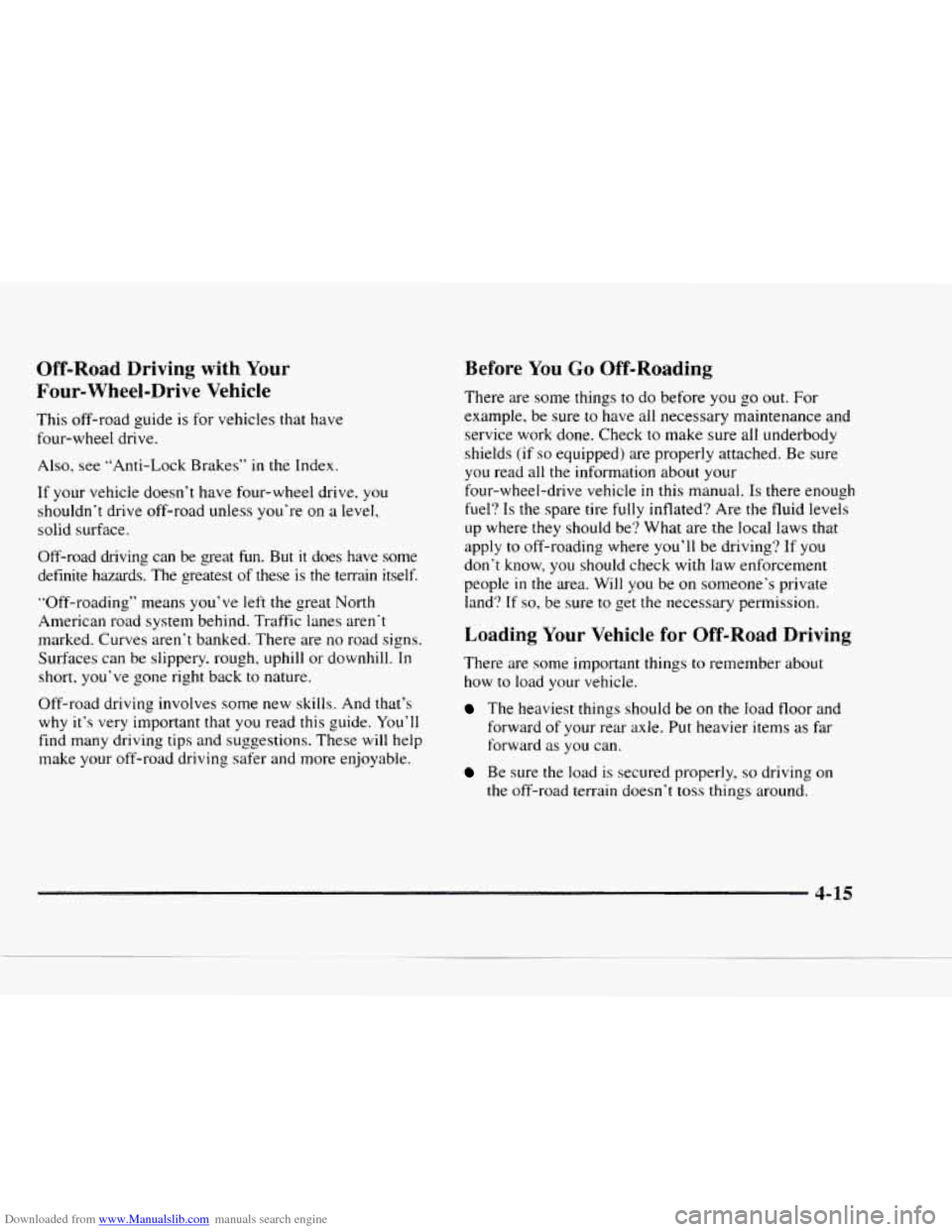
Downloaded from www.Manualslib.com manuals search engine Off-Road Driving with Your
Four-Wheel-Drive Vehicle
This off-road guide is for vehicles that have
four-wheel drive.
Also, see “Anti-Lock Brakes”
in the Index.
If your vehicle doesn‘t have four-wheel drive, you
shouldn‘t drive off-road unless you‘re on a level,
solid surface.
Off-road driving can be great
fun. But it does have some
definite hazards. The greatest
of these is the terrain itself.
“Off-roading” means
you’ve left the great North
American road
system behind. Traffic lanes aren‘t
marked. Curves aren’t banked. There are
no road signs.
Surfaces can be slippery. rough, uphill
or downhill. In
short. you’ve gone right back to nature.
Off-road driving involves some new skills. And that’s
why it’s very important that you read this guide. You’ll
find many driving tips and suggestions. These will help
make your off-road driving safer and more enjoyable.
Before You Go Off-Roading
There are sutfre things to do before you go out. For
example, be sure
to have all necessary maintenance and
service work done. Check
to make sure all underbody
shields
(if so equipped) are properly attached. Be sure
you read all the information about your
four-wheel-drive vehicle
in this manual. Is there enough
fuel?
Is the spare tire fully inflated? Are the fluid levels
up where they should be? What are
the local laws that
apply to off-roading where you’ll be driving? If
you
don’t know, you should check with law enforcement
people
in the area. Will you be on someone’s private
land?
If so, be sure to get the necessary permission.
Loading Your Vehicle for Off-Road Driving
There are some important things to remember about
how
to load your vehicle.
The heaviest things should be on the load floor and
forward of your rear axle. Put heavier items as far
forward
as you can.
Be sure the load is secured properly, so driving on
the off-road terrain doesn’t toss things around.
4- 15
Page 241 of 402
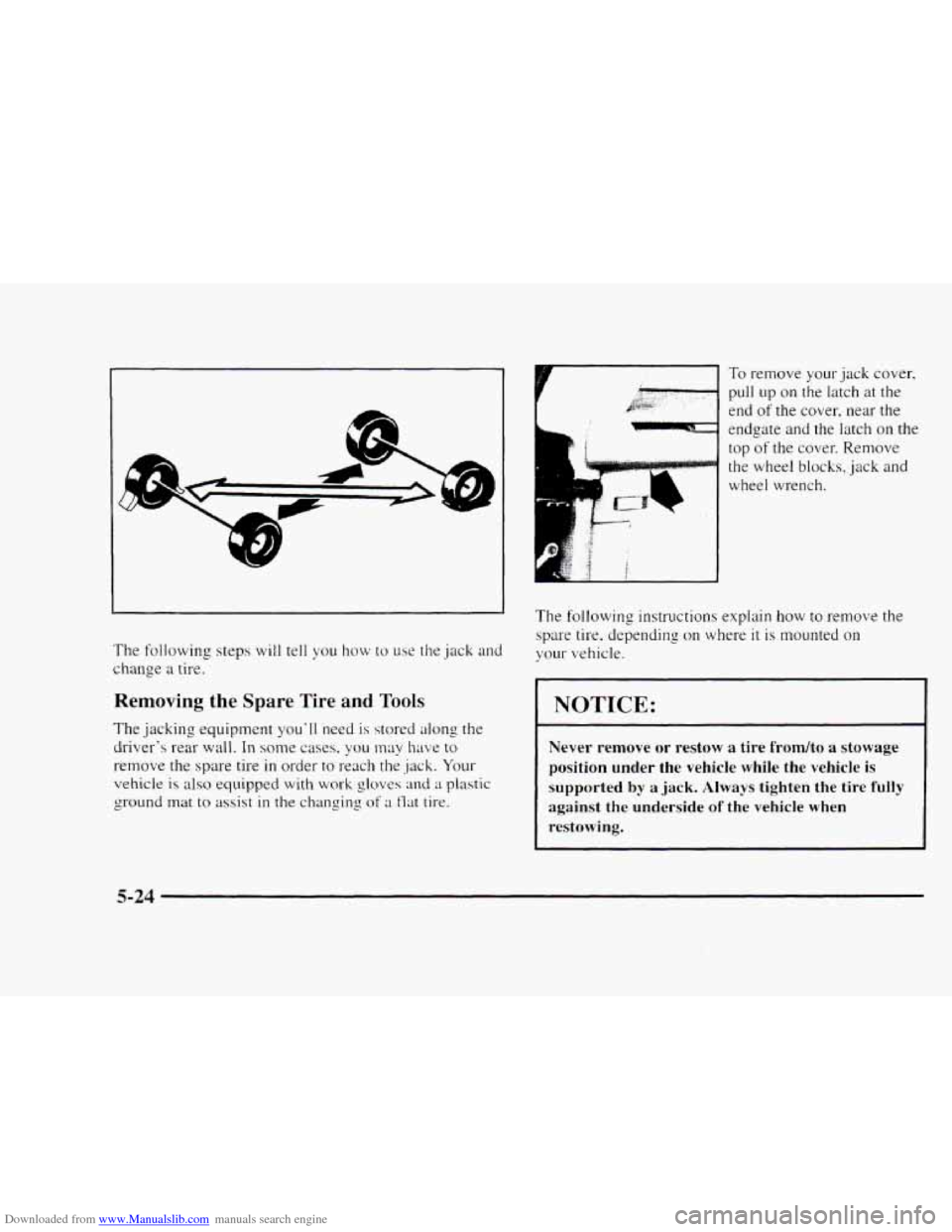
Downloaded from www.Manualslib.com manuals search engine The following steps will tell you how to use the jack and
change a tire.
Removing the Spare Tire and Tools
The jacking equipment you'll need is stored along the
driver's rear wall.
In some cases. you may have to
remove the spare tire
in order to reach the jack. Your
vehicle is
also equipped with work gloves and a plastic
ground mat
to assist in the changing of a flat tire.
h
To remove your jack cover,
pull up on the latch at the
end
of the cover, near the
endgate and the latch
on the
top
of the cover. Remove
the wheel blocks, jack and
wheel wrench.
The following instructions explain
how to remove the
spare tire, depending on where it is mounted on
your vehicle.
[ NOTICE:
Never remove or restow a tire frodto a stowage
position under the vehicle while the vehicle
is
supported by a jack. Always tighten the tire fully
against the underside
of the vehicle when
restowing.
5-24
Page 242 of 402
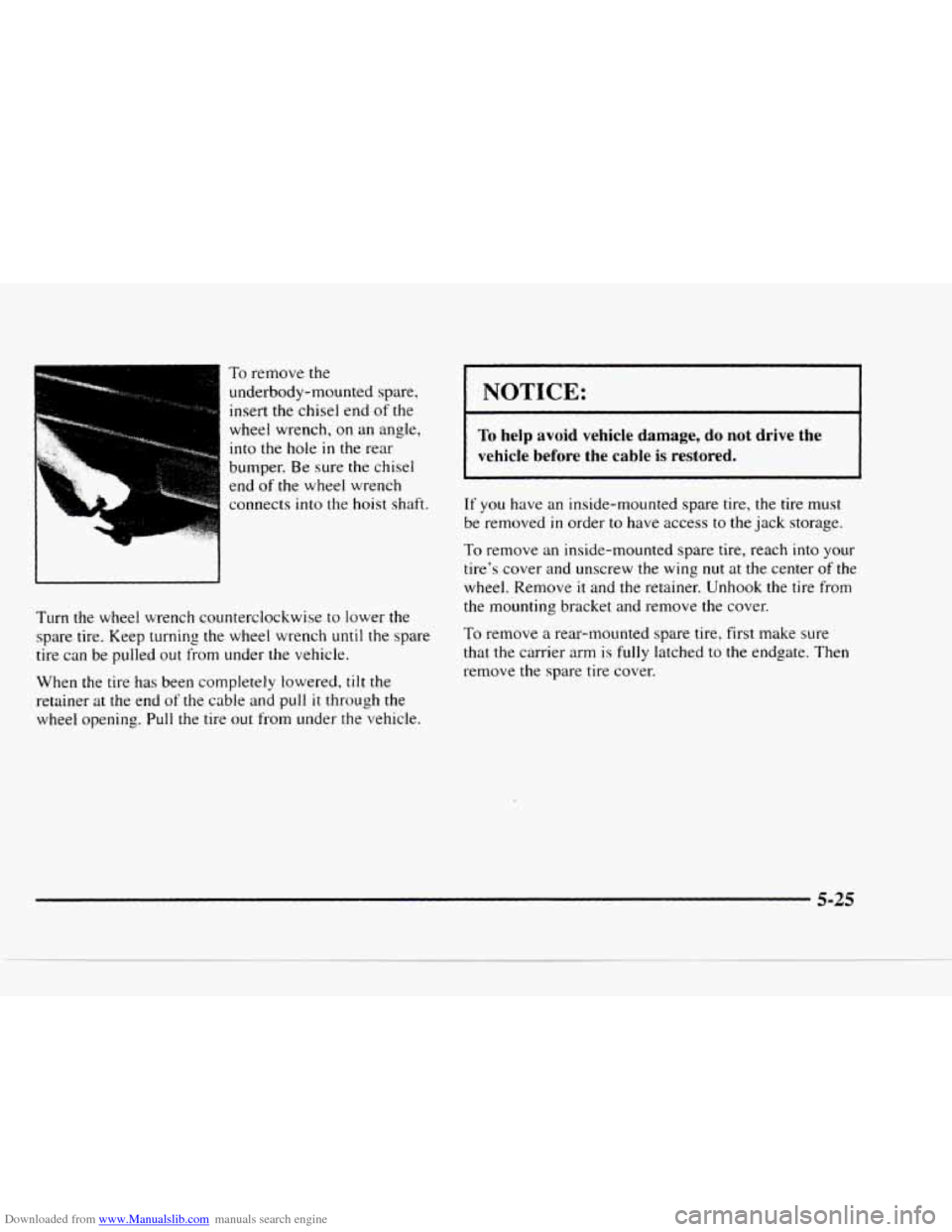
Downloaded from www.Manualslib.com manuals search engine To remove the
underbody-mounted spare,
insert the chisel end of the
wheel wrench,
on an angle,
into the hole in the rear
bumper. Be sure the chisel
end
of the wheel wrench
connects
into the hoist shaft.
Turn the wheel wrench counterclockwise
to lower the
spare tire. Keep turning the wheel wrench
until the spare
tire can be pulled out from under the vehicle.
When the tire
has been completely lowered, tilt the
retainer at
the end of the cable and pull it through the
wheel opening. Pull the tire out from under the vehicle.
I NOTICE:
To help avoid vehicle damage, do not drive the
vehicle before the cable
is restored.
If you have an inside-mounted spare tire, the tire must
be removed
in order to have access to the jack storage.
To remove an inside-mounted spare tire, reach into your
tire's cover and unscrew
the wing nut at the center of the
wheel. Remove
it and the retainer. Unhook the tire from
the mounting bracket and remove the cover.
To remove
a rear-mounted spare tire, first make sure
that the carrier arm is
fully latched to the endgate. Then
remove the spare
tire cover.
Page 243 of 402

Downloaded from www.Manualslib.com manuals search engine I
The locking wheel nut can
be removed by snapping the
rubber weather cover
off the
face
of the lock case.
Insert the key
and pull
the lock case straight off.
It is not necessary to turn
the key.
Put the spare tire near the flat tire.
The tools you'll be using include the jack (A) and wheel
wrench
(B). Your vehicle may also have an optional hub
cap removal tool.
Page 246 of 402
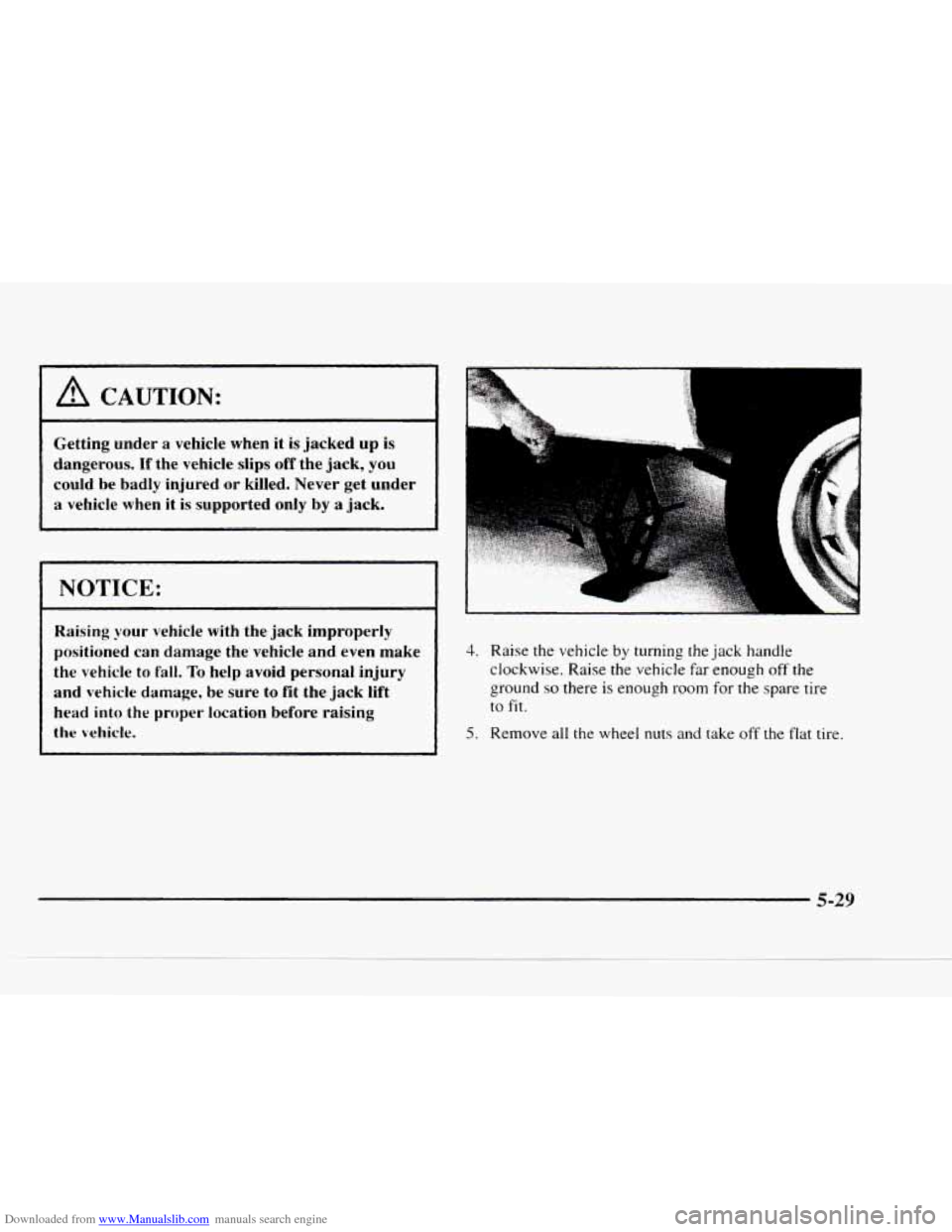
Downloaded from www.Manualslib.com manuals search engine I /d CAUTION:
Getting under a vehicle when it is jacked up is
dangerous.
If the vehicle slips off the jack, you
could be badly injured
or killed. Never get under
a vehicle
when it is supported only by a jack.
I NOTICE:
Raising your vehicle with the jack improperly
positioned can damage the vehicle and even make
the vehicle to fall.
To help avoid personal injury
and vehicle damage, be sure to
fit the jack lift
head into the proper location before raising
the vehicle.
a
4. Raise the vehicle by turning the jack handle
clockwise. Raise the vehicle far enough
off the
ground
so there is enough room for the spare tire
to fit.
5. Remove all the wheel nuts and take off the flat tire.
Page 247 of 402
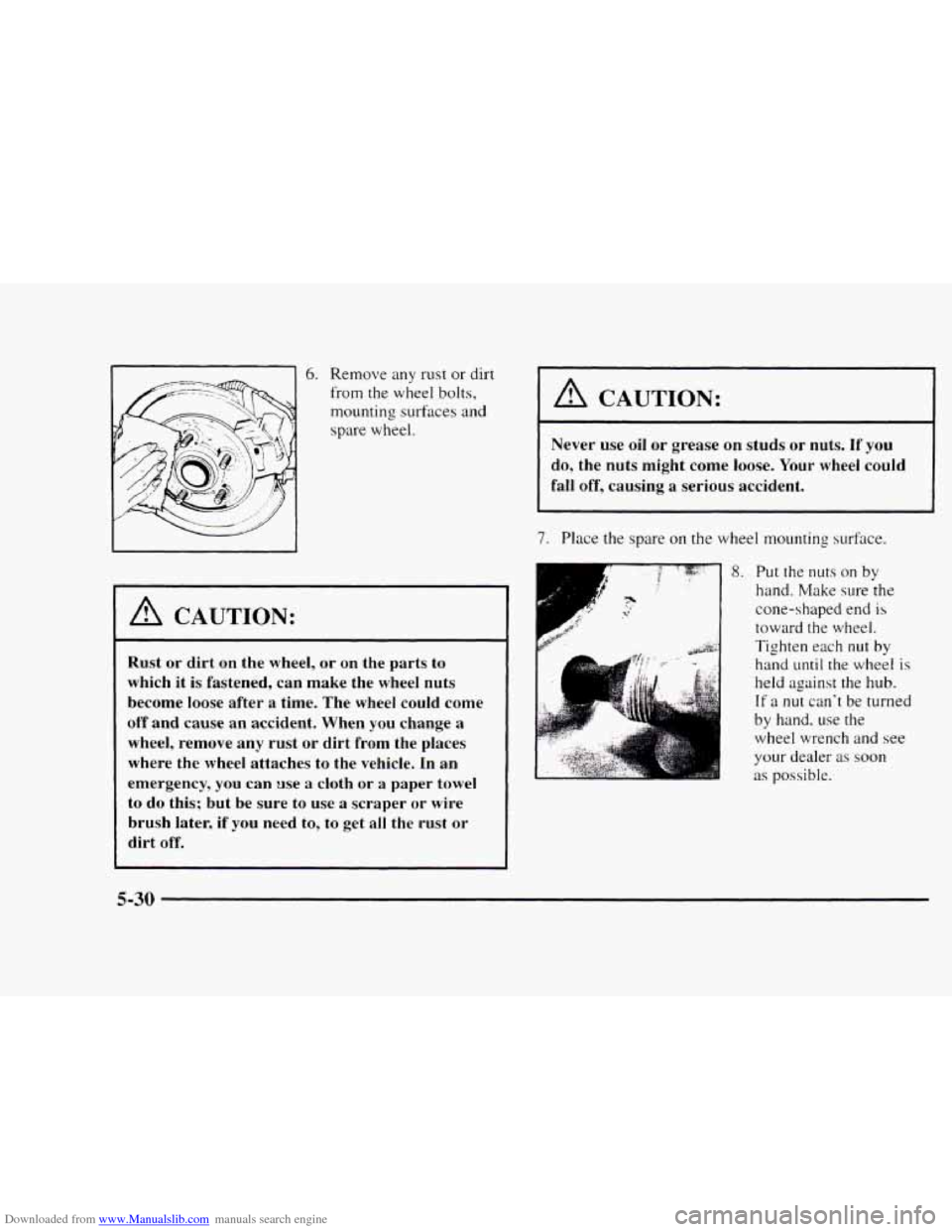
Downloaded from www.Manualslib.com manuals search engine 6. Remove' any rust or dirt
from
the wheel bolts,
mounting surfaces and
spare wheel.
A CAUTION:
Rust or dirt on the wheel, or on the parts to
which it
is fastened, can make the wheel nuts
become loose after
a time. The wheel could come
off and cause an accident. When
you change a
wheel, remove any rust or dirt from the places
where the wheel attaches to the vehicle. In an
emergency, you can use
a cloth or a paper towel
to do this; but be sure to use a scraper or wire
brush later, if
you need to, to get all the rust or
dirt off.
I A CAUTION:
~~
Never use oil or grease on studs or nuts. If you
do, the nuts might come loose. Your wheel could
fall off, causing a serious accident.
7. Place the spare on the wheel mounting surface.
8. Put the nuts on by
hand. Make sure the
cone-shaped end is
toward the wheel.
Tighten each nut by
hand until the wheel is
held against the hub.
If a nut can't be turned
by hand. use the
wheel wrench and see
your dealer as
soon
as possible.
5-30
Page 249 of 402
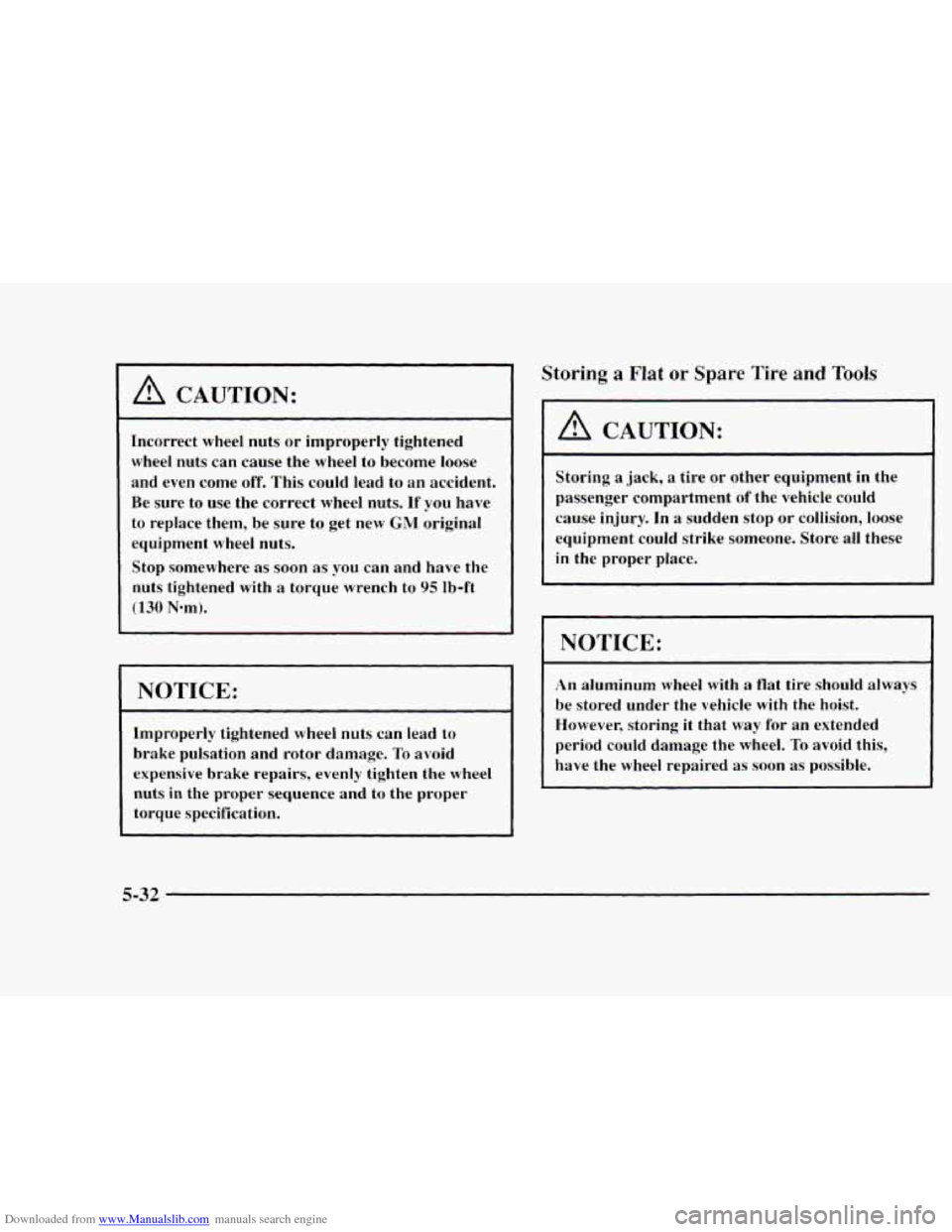
Downloaded from www.Manualslib.com manuals search engine A CAUTION:
Incorrect wheel nuts or improperly tightened
wheel nuts can cause the wheel to become loose
and even come
off. This could lead to an accident.
Be sure to use the correct wheel nuts.
If you have
to replace them, be sure to get new
GNI original
equipment wheel nuts.
Stop somewhere
as soon as you can and have the
nuts tightened with
a torque wrench to 95 lb-ft
(130 Nom).
NOTICE:
Improperly tightened wheel nuts can lead to
brake pulsation and rotor damage. To avoid
expensive brake repairs, evenly tighten the wheel
nuts in the proper sequence and to the proper
torque specification.
Storing a Flat or Spare Tire and Tools
A CAUTION:
Storing a jack, a tire or other equipment in the
passenger compartment
of the vehicle could
cause injury. In a sudden stop or collision, loose
equipment could strike someone. Store all these
in the proper place.
NOTICE:
An aluminum wheel with a flat tire should always
be stored under the vehicle with the hoist.
However, storing it that way for an extended
period could damage the wheel.
To avoid this,
have the wheel repaired
as soon as possible.
Page 250 of 402

Downloaded from www.Manualslib.com manuals search engine Follow this diagram to store the underbody-mounted spare.
Y; BJ
A. Retainer
B. Valve Stem
(Pointed Down)
C. Spare or Flat Tire
D. Spring
E. Wheel Wrench
E Lower
G. Raise
H. Hoist Arm
1. Put the tire on the ground at the rear of the vehicle,
with the valve stem pointed down and to the rear.
2. Pull the retainer through the wheel.
3. Put the chisel end of the wheel wrench, on an angle,
through the hole
in the rear bumper and into the hoist
shaft. Turn the wheel wrench clockwise
until the tire
is raised against the underside of the vehicle.
You
will hear two “clicks“ when the tire is secure,
but pull on the tire to make sure.
5-33
Page 251 of 402
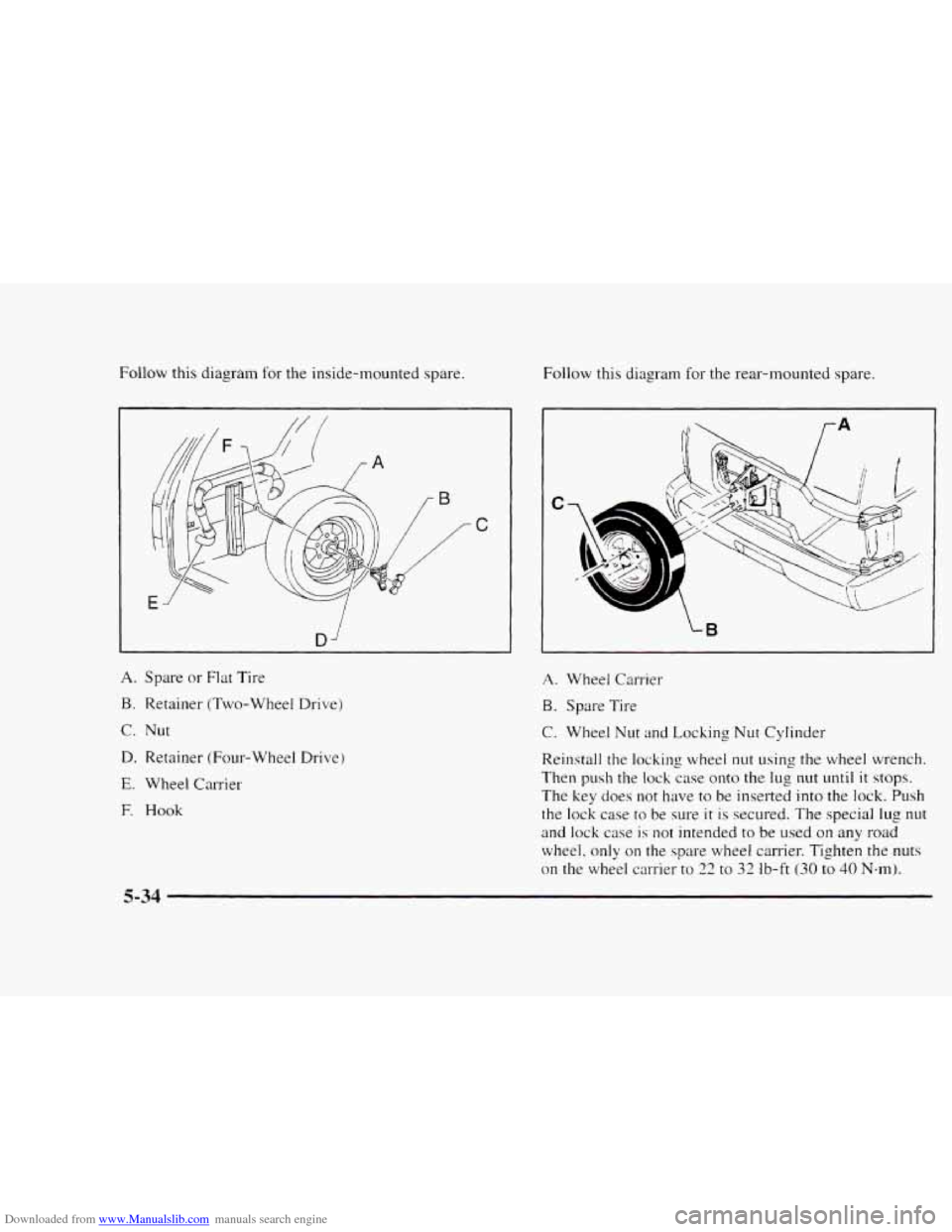
Downloaded from www.Manualslib.com manuals search engine Follow this diagram for the inside-mounted spare. Follow this diagram for the rear-mounted spare.
C
D i
C7
- i,
A. Spare or Flat Tire
B. Retainer (Two-Wheel Drive)
C. Nut
D. Retainer (Four-wheel Drive)
E. Wheel Carrier
E Hook
A. Wheel Carrier
B. Spare Tire
C. Wheel Nut and Locking Nut Cylinder
Reinstall the locking wheel
nut using the wheel wrench.
Then push the lock case onto
the lug nut until it stops.
The key does not have to be inserted into the lock. Push
the lock case to be sure
it is secured. The special lug nut
and lock case is not intended to be used on any road
wheel.
only on the spare wheel carrier. Tighten the nuts
on the wheel carrier to 22 to 32 Ib-ft (30 to 40 N-m).
Page 252 of 402
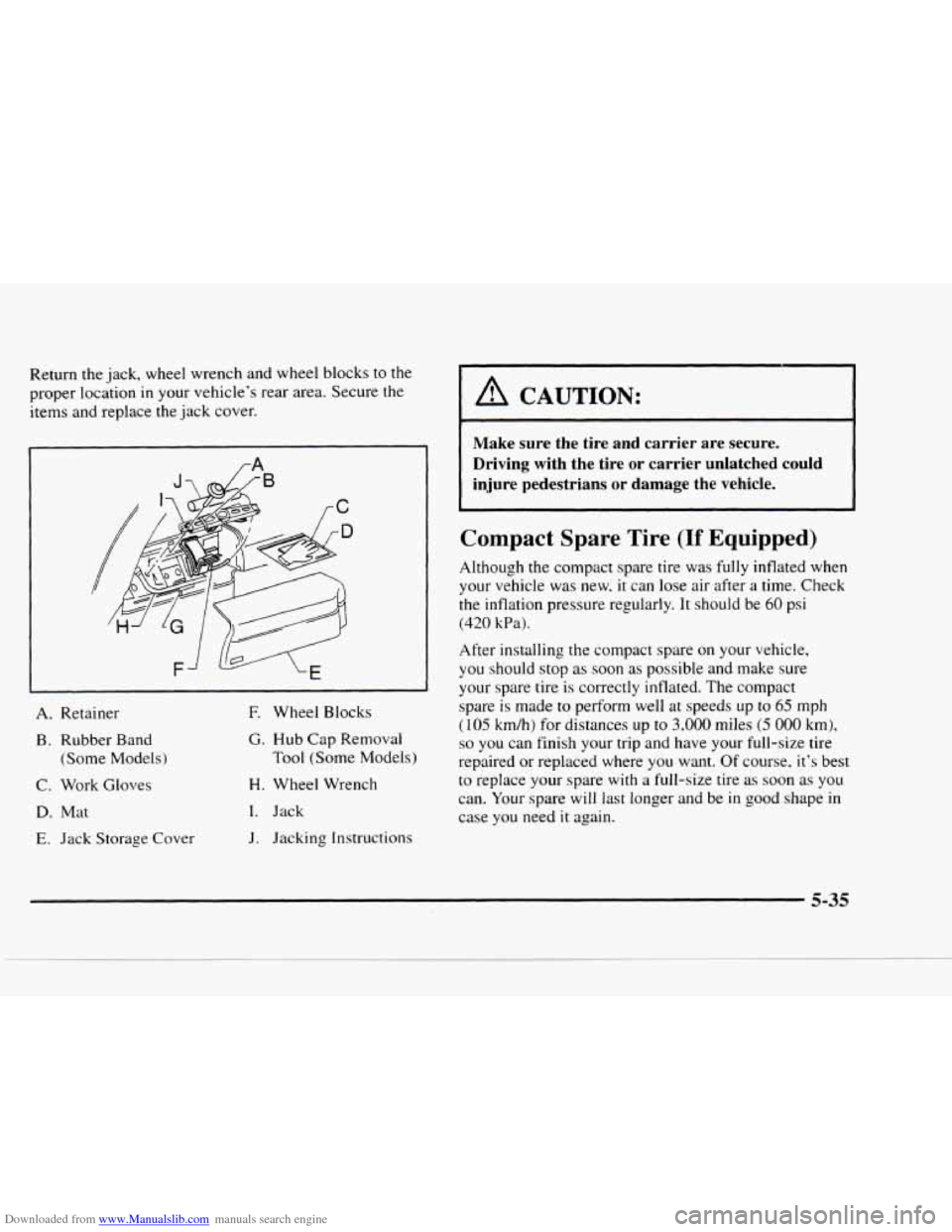
Downloaded from www.Manualslib.com manuals search engine Return the jack, wheel wrench and wheel blocks to the
proper location
in your vehicle’s rear area. Secure the
items and replace
the jack cover.
I
-
A. Retainer E Wheel Blocks
B. Rubber Band
(Some Models
j
C. Work Gloves
D. Mat
E. Jack Storage Cover
G. Hub Cap Removal
Tool (‘Some Models)
H. Wheel Wrench
I. Jack
J. Jacking Instructions
I A CAUTION:
I
Make sure the tire and carrier are secure.
Driving with the tire or carrier unlatched could
injure pedestrians
or damage the vehicle.
Compact Spare Tire (If Equipped)
Although the compact spare tire was fully inflated when
your vehicle was new,
it can lose air after a time. Check
the inflation pressure regularly. It should be 60 psi
(420 kPa).
After installing the compact spare on your vehicle,
you should stop as
soon as possible and make sure
your spare tire
is correctly inflated. The compact
spare
is made to perform well at speeds up to 65 mph
(105 km/h) for distances up to 3,000 miles (5 000 km),
so you can finish your trip and have your full-size tire
repaired or replaced where
you want. Of course, it’s best
to replace your spare with a full-size tire as soon as you
can. Your spare will last longer and be in good shape in
case you need
it again.
5-35